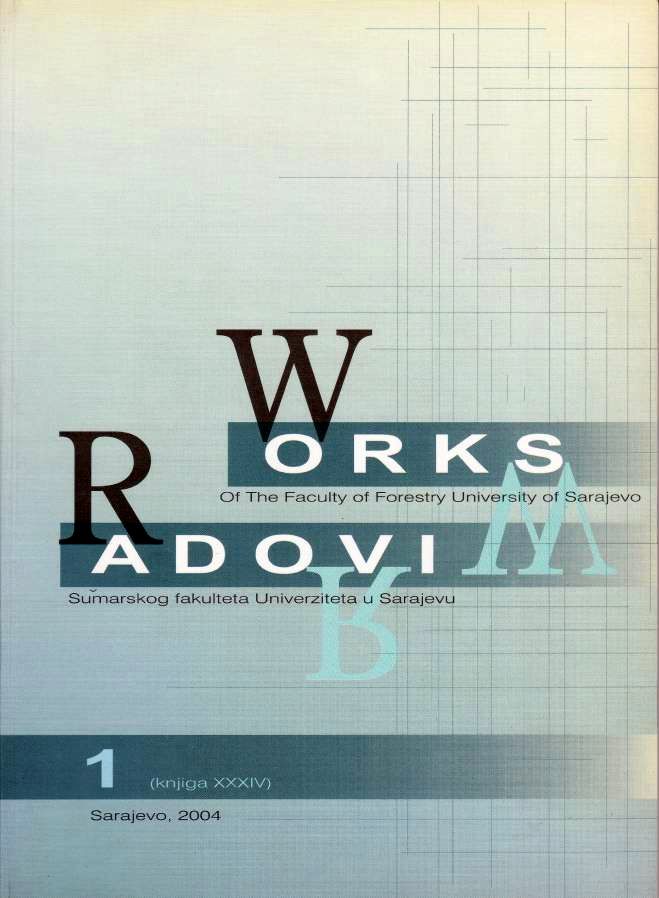CONTRIBUTION TO KNOWLEDGE OF NURSERY PRODUCTION OF AUSTRIAN PINE (Pinus nigra Arn.)
DOI:
https://doi.org/10.54652/rsf.2004.v34.i1.204Keywords:
Austrian pine (Pinus nigra Arn.), seed processing, seed density/filledAbstract
UDK 630*232:582.475
The investigation used Austrian pine seed originating from the clonal seed orchard "Prkos" (unacknowledged), Forest Administration Branch Office Gospić, Forest Office Gospić (crop 2001), processed during the winter of 2001/2002 in the seed extraction plant of the Jastrebarsko Forest Research Institute (ROTH 2002).
During sowing in the nursery seed selection plant, the amount of seedlings per unit of area was essential (depending on the period in the seed selection plant), which depends on the quality of seed (seed density/filled, cleanness, germination capacity, etc), and on the amount of the seed sown (piece/m2 or g/m2), which is determined by a formula, on the basis of which the required amount of seed is obtained for the desired number of plants. Until now in forestry practice mainly the norms achieved from practice and the method of calculating the number, i.e. amount of seed per m2 , have mainly been used for deciding on sowing density.
Investigations carried out by the authors clearly show that with processed seed (up to 98 % density, filled) from a smaller number of seeds a larger number of plants was obtained compared to the number of plants obtained from lower quality processed seed (Tables 2 and 3).
Furthermore, sowing based on the formula "1" (X = number of seed / m2) 40
% to 45 % of the desired number of plants can be obtained (desired number "A", Table 2). While sowing the seed amount by the formula "2" (N = amount of seed in g / m2) 3.5 times more Austrian pine plants were obtained than the desired number (desired number "V").
On the basis of these investigations it can be concluded that in the case of formula "1"
: X = A / č k e, for the purpose of accuracy, the numerator (or the right side) should be multiplied by 2, while in the case of formula "2" : N = (10 V A / K Č) k, instead of number 10 in the numerator, number 3 should be used, or the whole right side should be divided by 3.
By altering the existing formulae for calculation of the required amount of seed for the desired number of plants, greater accuracy would be achieved, which was confirmed in these investigations of Austrian pine seed.
Downloads
References
Matić, S; Oršanić, M; Orlić, S; Anić, M. (2001): Sjemenarstvo, rasadnička proizvodnja i šumske kulture obične jele (Abies alba Mill.). U: Obična jela u Hrvatskoj: 375 – 393, Akademija šumarskih znanosti, «Hrvatske šume», p.o. Zagreb, Zagreb.
Regent, B. (1972): Šumsko sjemenarstvo. Poslovno udruženje šumsko privrednih organizacija, 196 str., Zagreb.
Roth, V. (2000): Prilog poznavanju dorade sjemena običnog bora (Pinus sylvestris L.). Rad. Šumar. inst. 35 (2): 5 – 16, Jastrebarsko.
Roth, V. (2002): Prilog poznavanju rezultata dorade sjemena crnog bora (Pinus nigra Arn.) iz pet sjemenskih sastojina u Hrvatskoj. Rad. Šumar. inst. 37 (1): 19 – 35, Jastrebarsko.Roth, V. (2003): Prilog poznavanju dorade sjemena obične smreke (Picea abies L. / Karst.). Rad. Šumar. inst. : 38 (1): 23 – 33, Jastrebarsko.
Šmelkova, L. (1969): Zakladanie lesa. Tehnicka univerzita vo Zvolen, 239 str., Zvolen.
Vidaković, M. (1982): Četinjače – morfologija i varijabilnost. Akademija znanosti i umjetnosti, Zagreb.
Žgela, M. (1999): Proizvodnja šumskog sjemena u sjemenskim plantažama. Rad. Šumar. inst. 34 (1): 103 – 121, Jastrebarsko.






















